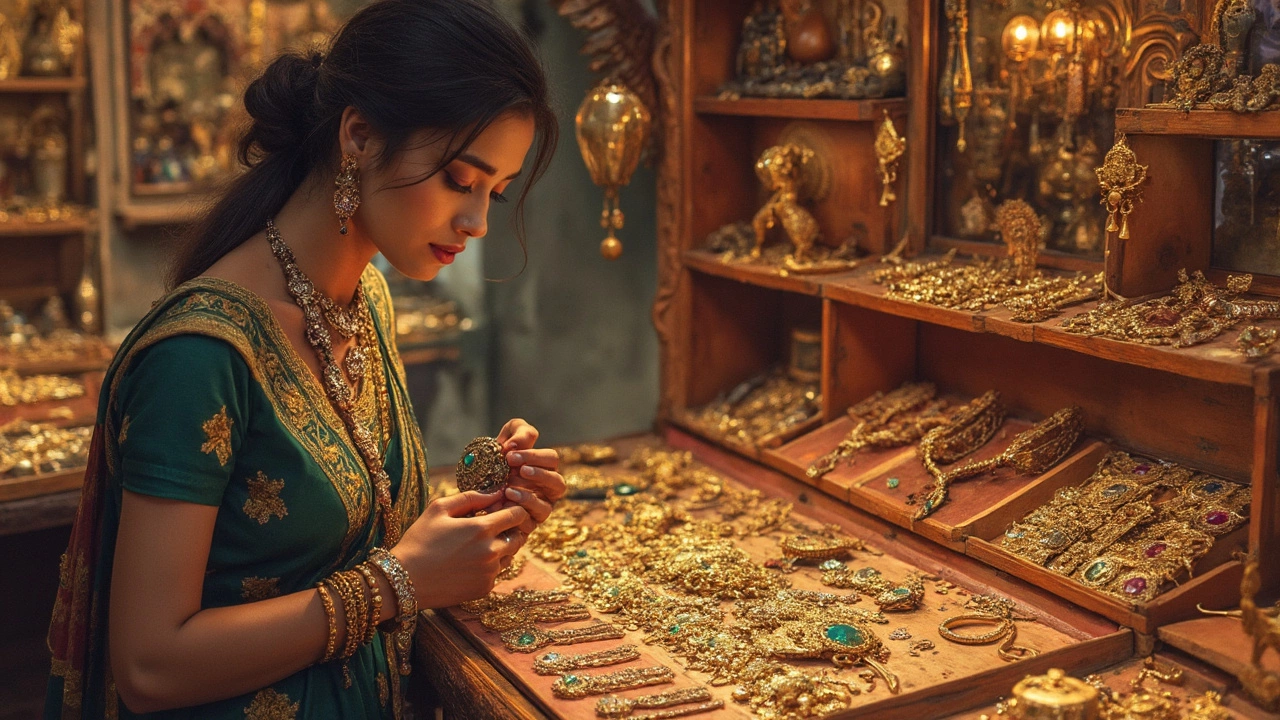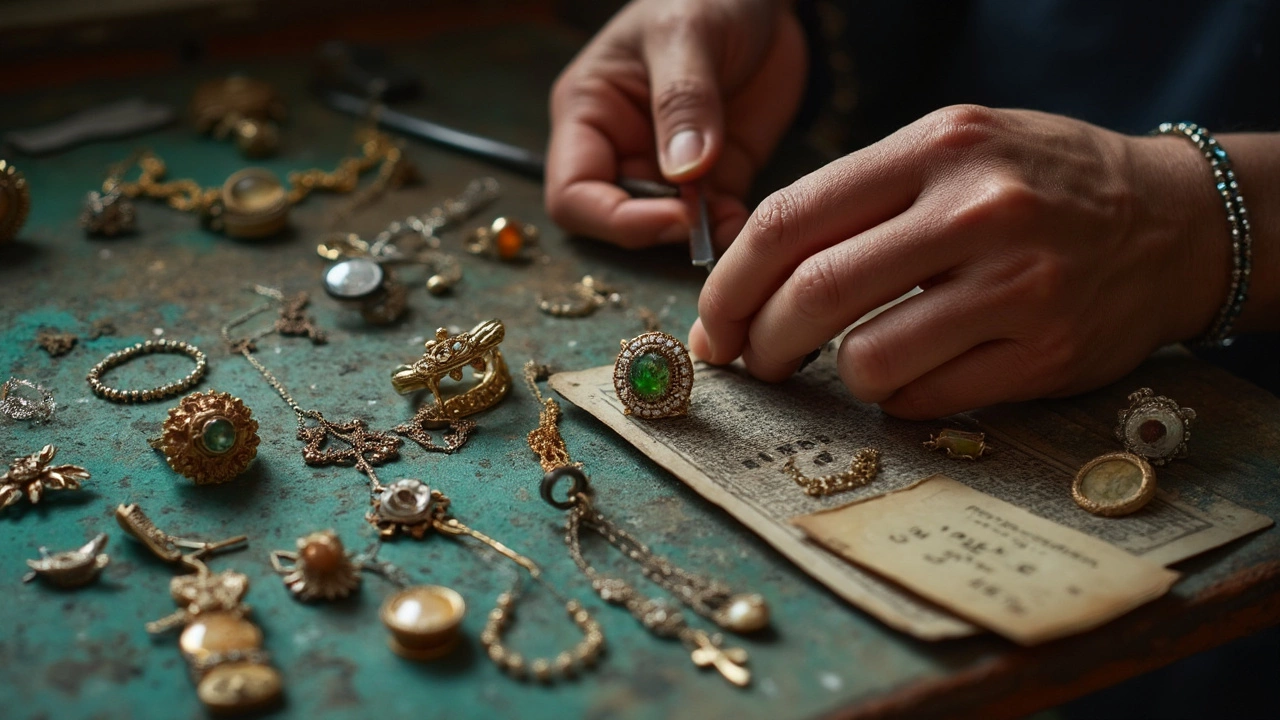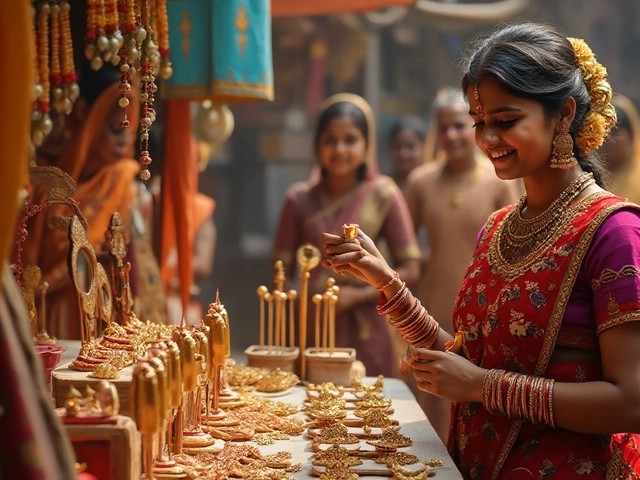
If you’ve ever poked around estate sales or inherited a box of old rings, at some point you’ll wonder: is any of this vintage jewelry actually worth real money? Forget the TV shows where someone finds a fortune behind grandma’s couch. In real life, most old jewelry doesn't turn into instant riches—unless you know exactly what to look for.
Here’s the first thing people get wrong: age alone isn’t a guarantee. Something can be 100 years old and barely worth the price of dinner, while another piece from the 1970s could put a down payment on a car. It isn’t about being "old"—it’s about demand, design, and a few surprisingly simple details you can spot if you know where to look. That’s the kind of stuff that actually keeps value steady or even makes it climb.
- Why People Think Vintage Jewelry Holds Value
- What Actually Affects Value Over Time
- How to Spot Pieces That Keep Their Worth
- Mistakes and Tips for Buying or Selling
Why People Think Vintage Jewelry Holds Value
Most folks hear the word “vintage” and instantly picture dollar signs, but that’s not always grounded in reality. Over the years, old jewelry has built up a reputation for being valuable, mostly because of a few standout moments—like diamond auctions making headlines or a celebrity’s brooch fetching six figures. The truth is, a lot of that belief comes from myths, TV, and a few extreme examples rather than what’s sitting in your jewelry box right now.
One big reason people hold onto this idea is that certain vintage pieces—think signed Tiffany or Cartier jewelry, original Art Deco rings, or anything with top-notch diamonds—really have held or grown in value. Auction houses love these pieces, and their prices are easy to track. When The Oppenheimer Blue diamond ring sold for over $57 million at Christie’s in 2016, stories like that made everyone believe old jewelry in general must be worth a lot.
Besides brand names, there’s something about the history tied to old jewelry. It feels rare, and anything rare seems like a good bet. Shoppers also know modern jewelry uses lots of mass-production, while older pieces were often made by hand, making them feel even more special—and, hopefully, valuable.
There’s also the idea that gold, platinum, and gemstones don’t lose value over time. It’s true that metals like gold can drive up the baseline price, especially if their market value goes up. But focusing too much on melt price alone leaves out other factors that actually make vintage jewelry desirable (and valuable) for collectors.
What really feeds the idea is word of mouth. Stories pass down in families about that “lucky” aunt who auctioned off an old ring and paid off her house. While those stories happen, they’re the exception, not the rule. People remember the wins and forget all the costume jewelry that never leaves the yard sale table.
What Actually Affects Value Over Time
Most people think vintage jewelry gets more valuable just because it’s old—nope, there’s more to it. The real drivers are way more practical. Rarity, condition, brand, and materials make the biggest difference, and the market cares way more about these than about how dusty a piece is.
Rarity is huge. If a piece was mass-produced, value almost always stays low. Think about it: a 1920s ring from a famous, limited collection is miles above a random department store brooch from the same year. Top brands like Cartier and Tiffany & Co. hold steady, and their pieces are actually seeing about a 15-20% price jump on the resale market in just the last five years. Authenticity matters too—restored or tweaked pieces lose big-time value, while untouched originals are gold (sometimes literally).
Materials are key. Jewelry with real gold, platinum, and untreated natural gemstones keeps value much better than anything with synthetic stones or plated metal. Here’s a quick side-by-side so you get the idea:
| Feature | Keeps Value? | Notes |
|---|---|---|
| 18k or higher gold | Yes | High melt value, always in demand |
| Platinum | Yes | Rare & expensive to replace |
| Natural, untreated diamonds/gemstones | Yes | Collectors pay a premium |
| Synthetic stones/plated metal | No | Value drops as soon as you leave the shop |
Condition is more important than you’d guess. Chips, repairs, or obvious wear drop prices fast, even for otherwise amazing pieces. Keep in mind, jewelry that’s been stored well—no bending, tarnish, or missing stones—keeps its shine in more ways than one.
Trends play a role too. Certain vintage jewelry styles—like Art Deco or mid-century modern—see waves of popularity. When celebrities wear a certain era, search and selling prices climb almost overnight. If you’ve got something from a hot style period, timing your sale can make a difference.

How to Spot Pieces That Keep Their Worth
So, you want to know if that old brooch or grandma's ring is the real deal? The truth is, some vintage jewelry isn't just nice to look at—it actually stays valuable (or even goes up) over time. Here’s what separates the winners from the stuff people forget about.
First up: designer names matter a lot. Brands like Cartier, Tiffany, and Van Cleef & Arpels almost never go out of style. Their logos or signature marks are something auction houses always check for, and results show pieces from top names consistently fetch higher prices. In 2024, Sotheby's reported a 35% premium on average for big-name Art Deco and Retro pieces over similar unsigned jewels.
Next, the materials should grab your attention. Solid gold or platinum has its own melt value, which means the piece won’t ever drop under a certain price (no matter the fashion). But things go way up if you’re talking about natural, untreated gemstones: think sapphire, emerald, or diamond—and even more so if they’re large and free of enhancements. Lab-created stones and gold plating just don’t hold up the same way.
Rarity counts too. If you spot something with an unusual setting, a weird cut of gemstone, or a production method that isn’t done anymore (like hand-chasing or certain enameling styles), it’s likely to have stronger demand. For example, Georgian and early Victorian jewels have surged in value because they’re hard to find in good condition and collectors will fight over unique craftsmanship.
Let’s get practical. Here’s a quick cheat sheet—if the answer is yes to any of these, look deeper:
- Is the maker’s mark readable and famous?
- Is the piece crafted in solid gold, platinum, or has natural diamonds/gemstones?
- Is the design easy to pair with modern outfits (think: not too fussy)?
- Does it have original packaging or documentation?
- Is it from a period currently in demand, like Art Deco (1920s) or Mid-century Modern (1950s-60s)?
There’s some actual data to back up what sells best. Check out this table from a 2024 jewelry auction trend report:
| Jewelry Period | Avg. Annual Value Increase | Most Sought-After Brands |
|---|---|---|
| Art Deco (1920s-30s) | 8.5% | Cartier, Boucheron |
| Retro (1940s) | 7.2% | Van Cleef & Arpels, Tiffany & Co. |
| Victorian (1837-1901) | 6.8% | Georgian makers, English hallmarks |
Want a safe bet? Stick to classic styles, big names, and top-notch materials. And if you’re ever unsure, a good appraiser (ideally one who isn’t selling you anything) can spot hidden value that online searches and quick guesses always miss. Don’t just go by gut—go by facts and details.
Mistakes and Tips for Buying or Selling
Jumping into vintage jewelry can be pretty exciting, but plenty of folks mess up and pay the price—sometimes literally. One of the biggest slip-ups? Assuming that a piece is valuable just because it looks old or has a famous maker's initials. Fakes are everywhere, and even genuine items can take a hit in value if they’re damaged or not all original.
Don’t just eyeball a piece and guess its value. Always check for stamps or hallmarks, which show metal content and sometimes the maker. If you skip this, you might pay gold prices for something that's just gold-plated. Also, condition is a major factor; broken clasps, missing stones, or obvious repairs can easily knock 40–60% off what it might fetch in top shape.
If you’re thinking about buying or selling, here are a few practical tips to stack the odds in your favor:
- Insist on paperwork or a legit appraisal. Big auction houses like Sotheby’s or Christie’s won’t even list a piece without documentation. Local jewelers can do it for a fee.
- Research recent sale prices online. Check finished sales on eBay, Ruby Lane, or auction sites with filters for vintage and era. Asking prices mean nothing; it’s what actually sold that matters.
- Beware of 'too good to be true' deals. Knockoffs with made-up hallmarks show up all the time, especially for certain Art Deco rings and Victorian brooches.
- Be honest about restoration. Fixing up a piece can help with durability, but over-restoration (like replacing all stones) usually hurts value.
- Store and handle pieces correctly. Scratches or bent prongs from bad storage can drop value fast, so use soft cloth pouches and avoid tossing pieces in a drawer.
Here’s what usually trips people up when it comes to vintage and antique jewelry investments:
| Mistake | Consequences |
|---|---|
| Ignoring hallmarks | Accidentally buying gold-plated or fake items |
| No condition check | Overpaying for damaged goods; hard to resell |
| Following hype, not data | Stuck with pieces that were never in high demand |
| Skipping appraisals | Unknowingly letting valuable pieces go for cheap |
| Poor storage | Quick loss in value due to new damage |
If you learn a little, move slow, and ask lots of questions, you’ll avoid most of the classic errors. A solid piece with good paperwork and a real track record can actually be a better investment than some stocks—plus it looks way cooler on your wrist.


